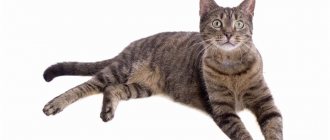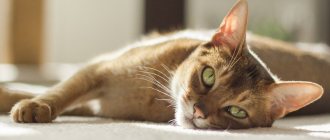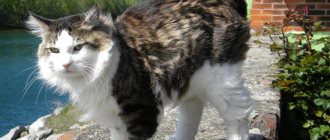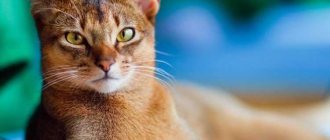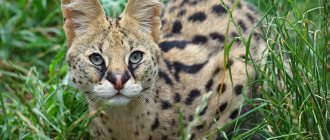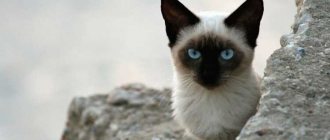A graceful beauty with a thousand-year history will easily find a place in the human heart and enter the very soul. The Abyssinian cat , with its strong, flexible and graceful body, commands respect not only from those who keep it, but also from everyone who watches the animal’s games and its behavior in general. Keeping such a charming animal in your home is a pleasure - caring for Abyssinians is not burdensome, which is also a significant advantage of this breed. The affectionate beauty also doesn’t mind settling in the house of a kind and sociable person - this creature brings real joy to the family!
History of the origin of the Abyssinian cat breed
global $ads_google;
//data-ad-slot=”2475549904″ $ads_google = empty($ads_google) ? false : true; ?> if ($ads_google == false) {?> $ads_google = true; ?> } ?> It is not only man who leaves a mark on history. Many cat tracks stretch from Abyssinia, or today's Ethiopia. This is one of the versions that explains the origin of this interesting graceful breed. There are also mentions of Abyssinians in the kingdom of Ancient Egypt. It is believed that these cats became the prototype of the goddess Bastet - a woman with a cat's head. There is an opinion that representatives of the Egyptian branch did not survive to this day, and today's beauties are only the result of the hard work of British breeders.
The first Abyssinian cat set foot on the shores of Great Britain in 1868, and just 3 years later the beautiful Zula was exhibited at the Crystal Palace. A year later, Abyssinian cats were talked about in the media. In 1874, a book by Gordon Stables was published, dedicated to the varieties of cat breeds, which already contained information about new cats.
12 years have passed since the Abyssinian pussy came to England, and the breed gained public recognition. They decided to consolidate and improve the qualities by crossing with a British shorthair cat.
After this, the popularity and prevalence of the Abyssinian cat in Europe and America began to grow rapidly. The first breeding cats and cats had a silver color and the remainder of the pattern in the form of stripes.
Silver-colored cats were discovered in America in 1907, but this color was not recognized by felinologists there, and in the 1920s there were almost none left in England. During the Second World War, cat populations declined greatly and recovered at a very slow pace. Even in 1978, after the feline leukemia epidemic, there were no more than a dozen manufacturers in England.
In the 21st century, the appearance of the breed has changed: the size of the animal has changed, the ears have grown, and many new colors have appeared. Today, Abyssinians are loved and popular all over the world.
Description of Abyssinian cats
global $ads_google;
//data-ad-slot=”2475549904″ $ads_google = empty($ads_google) ? false : true; ?> if ($ads_google == false) {?> $ads_google = true; ?> } ?> After a long selection, Abyssinian cats were divided into two types: the European type and the American one. Gradually, the differences between each species become more striking. Already now there is a noticeable difference in the skeleton and some features of the body structure.
Strict standards have been established for the wonderful Abyssinian cats. According to the description, the animals should not exceed average size and have a refined, flexible, muscular body.
The wedge-shaped head rests on a slender neck. The contours of the head are rounded, the muzzle should also not be sharp. The chin does not protrude.
The large ears are wide at the base and rounded towards the tips.
The Abyssinian's eyes should be large and very expressive, shaped like almonds. The breed's eye color can be either green or amber and includes a range between these characteristics.
The Abyssinian shorthair cat shows the world beautiful limbs, long, graceful and slender, with narrow and oval paws.
Descendants of cats from Abyssinia are the owners of a long tail, thickened at the base and pointed at the tip.
Graceful, sculpted cats have thick, short and silky fur with double and even triple ticking on each hair.
The breed is not on the list of hypoallergenic.
There is debate within organizations about acceptable colors. So far, several fur coat colors do not cause doubts and discord: blue, wild, sorrel, red, fawn.
The wild color will have a reddish-brown coat with black or dark brown ticking. The undercoat will be a beautiful orange-brown color.
The sorrel color is an offshoot of the wild color and is unique in the cat world. Only the Abyssinian breed has it. Reminiscent of a mixture of shades: copper, apricot, chocolate brown, red.
A warm beige coat color with slate gray ticking and a pink-beige undercoat is called a blue coat.
Flaming red is considered a red color, the undercoat coloring is also a reddish shade, and the ticking will be chocolate brown.
The faun has a pleasant pinkish-beige coat with the same undercoat. The light brown color of the ticking is interesting.
Dimensions and weight of Abyssinian cats
global $ads_google;
//data-ad-slot=”2475549904″ $ads_google = empty($ads_google) ? false : true; ?> if ($ads_google == false) {?> $ads_google = true; ?> } ?> The animals have a very proportional body and are considered average in size among domestic cats. Weight standards range from 4-7.5 kg. A weight of 5-6 kg is considered ideal, but this figure depends on gender, age, nutrition, castration or sterilization, and lifestyle. Don’t worry if a young cat weighs a little more than 4 kg, this is an indicator of the animal’s normal development.
As you can see, the growth and development of an Abyssinian kitten over the months is not very different from another medium-sized cat.
Table of approximate weight by month
| Age | Female | Male |
| 1 month | 290-600 gr | 520-800 gr |
| 2 months | 560-970 gr | 950-1600 gr |
| 3 months | 1.2-1.8 kg | 1.4-2.6 kg |
| 4 months | 1.6-2.5 kg | 1.7-3.7 kg |
| 5 months | 1.9-3 kg | 2.1-4.1 kg |
| 6 months | 2.1-3.5 kg | 2.5-4.4 kg |
| 8 months | 2.3-3.9 kg | 2.9-5 kg |
| 10 months | 2.7-4.2 kg | 3.4-5.9 kg |
| 1 year | 3.1-4.7 kg | 3.7-6.6 kg |
| 2 years | 3.6-6kg | 4-7.5 kg |
Appearance
Abyssinian cats have incredible strength and amazing flexibility. The cat's body is medium in size, with well-developed muscles and long legs. This structure ensures high mobility: the length of the jump can reach six times the length of the cat itself. As a rule, males are somewhat larger than females, but externally it is quite difficult to distinguish a cat from a cat. Average weight – from 3 to 4.5 kg.
The graceful gait and harmonious constitution demonstrates that cats belong to their wild relatives. At the same time, American cats look more elegant and light than the European version of the breed.
The wedge-shaped head is proportional and does not have pronounced planes or points. The nape line smoothly flows into a strong, sophisticated neck. The nose is neat, straight, of medium length, without humps. The chin has a rounded shape. The jaw muscles are strong. The contours of the muzzle are even; in mature males, small cheeks are sometimes visible. Cheekbones are pronounced. The pinch, a “sharp” face resembling a fox, is unacceptable for the standard.
Large, almond-shaped eyes are set widely at a slight angle. An oriental or round cut is not included in the standard and is considered a sign of mestizo. The color of the dark-rimmed eyes varies from amber to green. For silver cats, the most common eye color is green. And darkening in the corners of the eyes makes the upper eyelid visually more elongated.
The ears are set wide and have a slight tilt forward - this is the main “feature” of the appearance of the Abyssinians. The fur on the outside of the ears is short and has a so-called “thumb print” - a bald spot in the center.
The body is proportional, flexible and moderately elongated. The chest has a rounded shape. A slight deflection is visible on the back, but the hips should not be set low as standard. The paws are strong, long and thin. The fingers are pressed tightly together, it seems that the cat is walking on tiptoe. The tail of the Abyssinian cat is of impressive length, thin, with a pronounced narrowed tip.
The coat is dense, short, and has beautiful iridescence characteristic of the breed. There is a small undercoat, which is more pronounced on the back.
Features of color
The main feature of the breed is its rich color with unusual tints and no pattern. The natural beauty of a cat is ensured by the so-called ticking - a phenomenon due to which the fur can change several shades along its length. The hind legs, back and tip of the tail are usually darker than the rest of the body. But the inner thigh, stomach and chest have a lighter color. According to the standard, pronounced light hair can appear only on the chin or just below the nose. There are 4 generally recognized colors: Ruddy, Sorel, Blue and Fawn.
Ruddy
– wild color, which is the most common in this breed. The color range includes shades of ocher, as well as dark brown or black inclusions. The muzzle and tip of the tail may be shaded with black fur. Until 1963, "Ruddy" was the only color recognized for this breed.
Sorel
– “red” shade of fur, sometimes copper-red. The muzzle and tip of the tail have brown, apricot, or chocolate hairs. The presence of black hairs is unacceptable.
Blue
- a color in which the body has natural beige and gray shades, and the muzzle and tail are distinguished by thick, gray hair. Was officially recognized as the breed standard in 1984. The undercoat on the belly and inner thigh may have a pinkish tint. Fawn is the color of cocoa, or “coffee with milk.” This is a color of warm shades that range from beige and pink to chocolate. Fawn (“fawn”) is the rarest color, which is obtained only by combining two recessive genes.
Acceptable defects include a narrow or short rounded head, the presence of stripes on the paws, as well as pronounced cheeks in females. Also acceptable faults include light shades of the undercoat, round eyes and irregularly shaped ears. Unacceptable defects of the Abyssinians are the so-called “Siamese” physique, light spots on the coat, and an unbroken necklace on the chest or neck.
Character, behavior, temperament
In addition to their exotic appearance, Abyssinians are distinguished by unique behavioral traits. At some points in their lives, their behavior may resemble not a cat, but some wild animal that has never been domesticated. Abyssinian cats are born hunters, their activity is always at the top of their priorities. Constant movement is their vital necessity, because if an Abyssinian is inactive, it means he has health problems.
Curiosity is another trait that is very strong in this breed. These cats are interested in everything: how you load laundry, what you cook today, how you read a book, where you go, where and how you sleep. Their nose should definitely visit all, even the most secret places of your home. All tables and cabinets must be examined, both inside and outside. And even when the cat knows your house by heart, he will definitely find something to entertain himself with. Do you wash the dishes? The cat will try to help you, and, most likely, will be nearby to catch a stream of water with its paw. What do you mean you don't need help?!..
Cleverness makes it easy for pets to learn to open doors or taps, so take care of this in advance. And if you bring a new toy into the house, consider that it rightfully belongs to the cat. Abyssinians are terrible owners; they have absolutely no idea what it’s like to share.
Even if you have warned yourself a thousand times about the hyperactivity of the Abyssinian cat, you probably still have a lot to learn about them. Sometimes it seems like they have a whole jet engine hidden under their tail! An Abyssinian without movement can only be in a state of sleep. Like huskies, they are ready to jump, run and play 24 hours a day. And the presence of acrobatic skills allows pets to perform various tricks, a la running along walls, or somersaults in the air.
Such a cat will happily greet you from work right at the doorstep, meowing and purring. They do not tolerate loneliness well, so they need maximum attention and communication. Abyssinians are independent in nature, but often like to sleep with people in bed, hiding under the covers.
Continuing the theme of cat conversations, it is worth noting that the Abyssinian cat absolutely loves to talk. They really make a lot of sounds, either begging for food or simply because they are bored. Songs at 5 am is one of the surprises that awaits you when buying an Abyssinian cat. By the way, if the cat doesn’t like something, she can scold you for it in her own cat language. As for females in heat, here you will hear everything for yourself.
Despite their capricious nature, Abyssinians are quite affectionate and loving. They themselves seek affection, rubbing their heads and bodies on their arms and legs. Also, when demanding attention, they may bite your fingers, lick your hands, stomp on your legs, and allow themselves to be petted.
Abyssinian cats are quite smart and smart, so their learning ability is a very real thing. They can be taught basic commands and tricks, such as fetch or “give me your paw,” without much difficulty.
By the way, there is an opinion that becoming attached to their owners is the destiny of dogs. Cats tend to become attached to their homes. But with the Abyssinians it is a little different - they are not just dependent on a person, they choose a “leader” among the family, and obey only him.
Content Features
Of course, before the arrival of a kitten, you need to prepare in the same way as before the appearance of a human child. When you bring a kitten into your home, remember that it will experience stress. Therefore, provide your child with a leisurely and gradual introduction to the new environment. Allow the kitten to explore the environment, equip him with a sleeping place, and provide him with everything he needs - a scratching post, bowls, etc.
Thanks to their developed intelligence, these cats are easy to train to a tray or toilet. Bathing will also not be a big problem if you train your pet from a young age. By the way, you should not bathe the animal more than once per molt. When carrying out water procedures, you should use a high-quality shampoo for short-haired cats that does not contain conditioner. And to dry a cat after bathing, just wipe it with a towel and let it dry, preventing all sorts of drafts.
Abyssinian cats have strong teeth, but this does not mean that they do not require care. It is worth periodically inspecting your cat’s oral cavity and carrying out preventive dental cleanings to avoid the appearance of tartar. It is also worth cleaning your cat’s ears in a timely manner and keeping them clean. To clean your ears of dirt, take a cotton pad lubricated with Vaseline oil and gently rub it along the inner surface of your ear several times. Only the visible surface of the ear should be cleaned - do not reach inside the ear or use cotton swabs. If necessary, if your ears still seem dirty, contact your veterinarian.
The cat's coat allows owners not to bother with care. Brushing your cat once a week will be sufficient. The molting period in a healthy pet does not cause any particular inconvenience and passes quite quickly. Make sure that the tools for combing the cat do not have sharp elements - these cats have extremely delicate skin that can be easily injured. The ideal tool for combing an Abyssinian would be a special “mitten.”
Don't forget about nail hygiene. You can trim your claws yourself, using a special nail clipper, once every 2 weeks. The first time you can have this done is by a veterinarian, who will teach you how to properly trim nails and also show you how to avoid hitting blood vessels when trimming.
The nutrition of Abyssinian cats should be complete and balanced. They willingly eat both special food and natural food. In the second case, you should consult a veterinarian and select vitamins or nutritional supplements. Also pay attention to the portion size for the animal - overfeeding can have even worse consequences than underfeeding. It is advisable to give young cats under one year of age food three times a day. Since Abyssinians are prone to food allergies, when changing or selecting food, pay attention to the pet’s condition and behavior.
It is important to feed Abyssinian cats only food that has been heat-treated. It is not advisable to give raw foods, especially if you cannot be sure of their quality. Food should be a comfortable size, without large pieces that could cause the animal to choke. By the way, many Abyssinians enjoy eating fruits and vegetables.
Another important point in keeping any cat is its safety. Especially when it comes to curious and active cats. Make sure that there are anti-cat protective bars on the windows, that the entrance doors are closed, and that sharp or dangerous objects are out of the pet’s reach. Please note that cats love to play with shiny or rustling things, so your jewelry may not only be hidden by the cat under the sofa, but even accidentally swallowed.
In addition, Abyssinians can sometimes engage in petty theft. For example, your food from a plate can easily end up inside a cat in a matter of seconds. Due to excessive curiosity, they can also chew indoor flowers and unravel your carpet into small threads. Some indoor flowers are real poison for cats, and swallowed threads seriously injure the intestines - think about this in advance.
To keep a hyperactive cat occupied, you will need to build her a special place to play. Otherwise, she will choose what to play with. Just in case, check the cabinets, oven, microwave and washing machine for the presence/absence of a cat in them, which could climb inside purely out of curiosity.
Their canine habits sometimes play into people's hands. For example, an Abyssinian cat easily gets used to a collar or harness for walking, which simplifies the task of walking outside. Of course, this does not guarantee that letting your cat off leash is safe. After all, curiosity comes first for them.
Sickness of the breed
Like any breed, the Abyssinian has its weaknesses. This concerns, first of all, health, or more precisely, hereditary diseases. Veterinarians say that each breed has its own number of predispositions to certain ailments. But with a competent approach and timely prevention of these diseases, in most cases, owners manage to not only delay these diseases, but also prevent them, and even avoid them. What hereditary diseases of Abyssinian cats should the owner know about? Let's take a closer look.
Pyruvate kinase deficiency
. This pathology occurs not only in Abyssinian, but also in Somali cats. Pyruvate kinase is an enzyme that produces energy in blood components. Due to the lack of this substance in the cat’s body, red blood cells do not perform their functions and quickly die, which leads to a sharp decrease in hemoglobin levels - anemia. The main symptoms are lethargy, pale mucous membranes, loss of appetite. The presence of a disease in a cat can only be determined using special tests.
Kidney amyloidosis
. The disease is characterized by impaired protein metabolism in the kidneys, which subsequently provokes renal failure. Unfortunately, this disease is irreversible in most cases, and in the first stages it is practically asymptomatic. The life expectancy of cats with this disease is from 4 to 7 years, depending on the rate of progression of the disease. The first signs of the disease are digestive disorders - diarrhea, alternating with constipation, as well as refusal to eat and increased thirst.
Retinal atrophy
. This disease causes blindness. As a rule, it appears between the ages of 2 and 17 months. By the age of three, a cat can become completely blind. At first glance, the disease can be identified by the animal’s characteristic disorientation, which is especially evident when encountering obstacles, as well as when reacting to light. In this case, you should urgently contact a veterinary ophthalmologist and have your eyes examined.
Spontaneous hyperesthesia syndrome
. This disorder is purely neurological, and is manifested by nervous overexcitation of the pet, as well as an overly strong reaction to pain. One of the main symptoms is an inadequate response to touch.
Psychogenic alopecia
– a behavioral disorder in which a cat licks and chews its fur excessively. The consequence may be the appearance of bald patches and the development of dermatitis.
Who is the Abyssinian cat suitable for?
The main negative that owners associate with Abyssinian cats is excessive energy. Sometimes cats can act out, which often displeases their owners. Sometimes it begins to seem that the cat is everywhere, and “there are too many of them.” But these are characteristics of the breed, and you should think carefully before buying such a kitten.
You should definitely not choose an Abyssinian cat for those who:
- is practically not at home;
- loves peace and quiet;
- not ready to be financially responsible for the health and safety of the animal.
If all the pros and cons have already been weighed, and you have definitely decided on choosing an Abyssinian cat, then you can be sure that you will not exchange this breed for any other. This cat will love you sincerely, with all her heart. Well, if you are already the owner of an Abyssinian and you have something to say, share it with us in the comments!
Habits and character of Abyssinian cats
The characteristic behavior of cats can be different, but in the case of the Abyssinian cat, its character completely corresponds to its appearance. Just by looking at this graceful perfection, its playfulness and curiosity become apparent. These same character traits and at the same time amazing balance will not allow the cat to interfere excessively in the owner’s life, although the pet will not object to the manifestation of care from a loved one.
Both adults and children will enjoy the cat's sociability: they are affectionate and at the same time independent creatures. In order for an Abyssinian cat to honor its owner with its trust, judging by the reviews, the training process should not include harsh shouting, and it is even more unthinkable to use physical force.
How to litter train an Abyssinian kitten
The owners who keep an Abyssinian cat claim that this is a true, loyal friend. The animal is responsive to affection and pays in kind. These pets do not like loneliness. Although they do not get in the way of their household members, they nevertheless feel more comfortable knowing that their beloved owners are in the apartment nearby. Cats love to participate in family events, their natural curiosity pushes them to do so. This is partly why they willingly join in children's games; they do not need energy.
The favorite of the whole family is ready to get along with other pets: the Abyssinian kitten will happily add both a cat and a dog as friends, and will win this friendship with its kind character.
Abyssinians are smart and can be trained. Pretty soon they can already bring a small object to the owner. The habits of the animal and its desire to spend time actively will help with this. Well-mannered cats behave well during the exhibition, which invariably makes their owner proud.
How to raise and train Abyssinians
More than other animals, when raising and training a cat, the use of a human reward system is suitable. Affection is also a positive reinforcement, but a treat will work better.
A person who is afraid of or hostile to a cat will never be able to accustom the animal to even the most basic things. The tidbits won't help here: you can't bribe this animal, but you need to win affection and trust.
Education, like with people, begins at birth, and training from the moment when the cub looks at the world meaningfully. Learning techniques and tricks always begins with observing personal qualities and inclinations. Having noticed, for example, that the cat often carries objects in its teeth, you can give the command “Fetch” and encourage it at this time. Having repeated the procedure many times, the owner’s patience is the main trump card here! – you can achieve the execution of the commands “show stance”, “jump”. The formula “through natural desires and inclinations to obedience” works well in the case of cats, but getting them to do something that does not bring pleasure is almost impossible.
Feeding and caring for Abyssinian kittens
For those who do not like to spend a lot of time caring for their pet, an Abyssinian cat is ideal. Short hair will not burden the owner with long-term combing out of tangles or daily brushing, as required by the coat of long-haired cats.
global $ads_google; //data-ad-slot=”2475549904″ $ads_google = empty($ads_google) ? false : true; ?> if ($ads_google == false) {?> $ads_google = true; ?> } ?>
You can take care of the fur once a week - just brush the kitty with a brush with metal teeth and also bathe it during the molting period.
A scratching post installed in the house will solve problems with claw sharpening. Otherwise, you will have to give your cat a manicure on your own once a month. In order for a cat to allow his nails to be trimmed calmly, he is taught this process as a child.
Once a week, the ears are examined, which should be cleaned with a damp cloth, and the eyes; if necessary, they are wiped with a clean damp cloth.
Keeping such cats requires proper feeding—the quality of the food determines the pet’s health and appearance. An Abyssinian kitten is able to get used to the offered diet and not be mischievous.
Up to a year old, a growing kitten is offered food designed to meet the needs of each month of the baby's growth.
The Abyssinian breed needs wet and dry food. If you want to feed your pet natural products, they give preference to meat. It is better to boil the meat and offer it in pieces, but sometimes you can simply pour boiling water over it.
A cat can start breakfast with fermented milk products and porridge. Among the representatives of the breed there are ardent adherents of a vegetable diet - you should not deny your beloved cat such a whim.
How to choose a kitten
Contact only reputable breeders or large nurseries. You should adopt a kitten no earlier than three months of age. By this time, the seller manages to give the Abyssinian several vaccinations, accustom him to the tray, and transfer him to independent feeding. In addition, the baby will become psychologically stronger and will be ready to move to a new home. By taking your pet at an earlier age, you seriously risk its physical and emotional health.
Make sure that the breeder issues all medical certificates for the animal and a pedigree that will record the absence of inbreeding. The kitten should be playful, sociable, and not too timid. Shiny fur, a confident gait, the absence of palpable hernias on the abdomen, or discharge from the eyes or ears are the main signs of a healthy Abyssinian cat.
Health of Abyssinians
The excellent health indicators cannot be overestimated. Possible diseases include gingivitis, which develops as a result of an incorrectly selected diet. Regular teeth brushing will help solve the problem.
global $ads_google; //data-ad-slot=”2475549904″ $ads_google = empty($ads_google) ? false : true; ?> if ($ads_google == false) {?> $ads_google = true; ?> } ?>
Some cats develop a kidney disease called renal amyloidosis. The disease is not considered a hallmark of the health of this particular breed. In nurseries, when such heredity is identified, they approach the selection of breeding representatives strictly, not allowing the disease to be transmitted to the descendants of culled cats. It is also necessary to get all recommended vaccinations on time.
If you want to take part in the breeding of the breed, the pets are mated. After 63-65 days of quiet pregnancy, kittens will be born. The specific gestation period depends on heredity and the number of fruits. During childbirth, the owner must support the pet and provide her with the necessary assistance.
If offspring are not planned, it is better to castrate or sterilize the animal. The age of surgery for cats is 6-9 months, and for cats 7-12 months.
Timely vaccinations and a competent approach to maintenance will allow the cat to live next to its owner for many years. The life expectancy of an Abyssinian is 12-15 years .
Buy an Abyssinian kitten
The cost of an Abyssinian kitten remains consistently high: the price consists of the value of the breeding line, care for the cat during pregnancy and childbirth, care for growing kittens, their vaccination, nutrition and maintenance for the quarantine period after vaccination.
Full care and impeccable pedigree can only be provided on a contractual basis by specialized nurseries for breeding the Abyssinian breed. Third-party sellers, as a rule, cannot guarantee such conditions. The purity of the baby’s blood, his exhibition qualities and state of health are also questioned.
Kittens that will not take part in breeding in the future are 2-2.5 times cheaper than the same breed-class cats. Valuable breed lines are always sold with a ban on breeding. Externally, castrated and sterilized cats and female cats do not differ from their counterparts; they also take part in exhibitions in their categories.
The average price for an Abyssinian is 30,000-50,000 rubles
.
What to name an Abyssinian cat
Kittens receive their names, where the surname, or the prefix to the name, bears the name of the cattery. Most likely, at home you will want to name the cat differently, but the name given by the breeders will be written in the pedigree.
global $ads_google; //data-ad-slot=”2475549904″ $ads_google = empty($ads_google) ? false : true; ?> if ($ads_google == false) {?> $ads_google = true; ?> } ?>
In general, most often babies are given nicknames associated with anything: the appearance of pets, flowers, literary characters, the names of ancient pharaohs and geographical places. No one will deprive the owner of the right to name his favorite furry boy or girl, because whatever you name the ship, that’s how it will sail. But it should be understood that the name indicated in the metric will appear at the exhibition. To name a cat as your heart desires, you should agree on this with the breeder in advance. And names offered for the Abyssinian cat !
Name table
| Girl | Boy | ||
| Britney Bayra Adetta Lasta Hannah Gabby Credit Jucha Asta Iskra Rina Arleta Gotha Troya Safari | Bobbin Bast Shani Nut Munya Milana Lara Feri Ali Nut Eva Kusya Fanya Zhulya Korra | Charles Bridge Nathan Otto Cent Amon Tim Best Emir Sam Tormund Eraser Benu Silver Alf | Adis Archie Tutan Mike Pate Lexus Mouse Amber Sherlock Dust Argo Spot Zlatan Forex Charlie |
What does the price depend on?
The cost of an Abyssinian cat in Russia varies widely. The price is formed under the influence of a number of factors:
- The age of the kitten.
- Pedigree.
- Having titled parents.
- Animal class.
- Purebred.
- Health conditions.
- Color.
- Availability of a veterinary passport.
- Places of purchase.
- Availability of a veterinary card.
- The seller's pricing policy.
A purebred animal will cost more than a cross between a purebred cat and a barn cat. If you have veterinary documents (passports, cards), the price of the animal increases. The cost of kittens from titled parents is higher. A completely healthy cat will cost more than one that has some health problems.
Conclusions about the breed
What can an Abyssinian cat conquer? This breed is delightful for its appearance, smooth lines of a strong healthy body, and pronounced affectionate and sociable character.
A person who brings an Abyssinian into the house will immensely love such a smart and interesting cat, because she manages to find a common language with both the child and other pets.
This wonderful breed has good health, amazing silky hair and does not burden the owner with excessive demands on grooming.
Preparing for the appearance of an Abyssinian in the house
Before you bring the purchased kitten home, you need to carry out simple preparatory measures. These include:
- Purchasing a tray , litter, bowls for food and water, scratching posts, combs for wool, special cat toys, a carrier (if you plan to take your cat with you to the dacha).
- Preparing the bed. This can be a thick rug or pillow, a regular box with a blanket, or a special “cat house” that can be purchased at any pet store.
- Introduction to the basics of caring for Abyssinians. You can find information on the Internet or in print.
- Preparing the apartment for the appearance of an animal in it. This item includes placing house plants out of reach of the cat, removing wires and valuables, lifting curtains from the floor, etc.
- Study information about kitten sellers. It is better to buy an animal from trusted breeders, a pet store or specialized nurseries.
